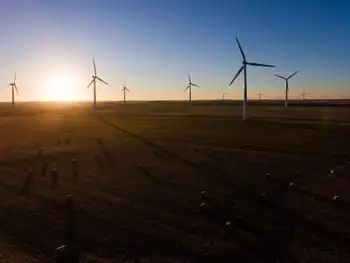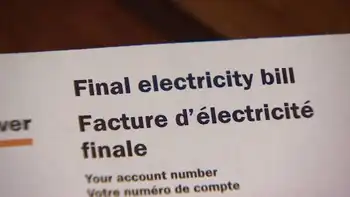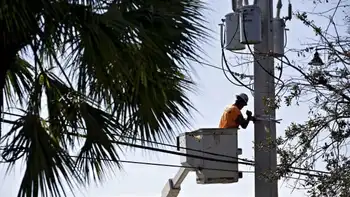Ontario goes solar
SARNIA, ONTARIO - The Ontario government has given approval for a California company to construct a massive solar "farm" near Sarnia that will blanket an area larger than all three Toronto islands with hundreds of thousands of sun-soaking panels.
It will be the largest solar power station in North America and among the most expansive in the world to use photovoltaic cells that produce electricity when exposed to sunlight. Once complete, the 40-megawatt Sarnia project will be able to supply enough emission-free electricity to power between 10,000 and 15,000 homes on sunny days.
"This is certainly the most exciting thing I've ever worked on," said Peter Carrie of OptiSolar Farms Canada Inc., a subsidiary of Hayward, Calif.-based OptiSolar Inc. "We want to take solar mainstream."
The Ontario Power Authority has agreed to purchase the electricity under a 20-year contract that will see the clean power go into the provincial grid.
The current world record-holder is the 12-megawatt Erlasee solar park in Germany, though another 40-megawatt park is under construction in the same region. The largest U.S. project was recently announced: A 15-megawatt solar PV system to be built at an air force base in Nevada.
The Sarnia solar farm will be enormous by comparison, stretching across nearly 365 hectares, the equivalent of 419 Canadian football fields. An army of panels will be erected as high as seven metres off the ground, all tilted south to soak up sunlight.
In a Canadian context, the magnitude is even more impressive. The 100-kilowatt solar installation atop Exhibition Place's historic Horse Palace, now the largest in Canada, is 400 times smaller than OptiSolar's proposed farm.
The company would not reveal the cost of the project for proprietary reasons, but Carrie said a typical 10-megawatt system runs between $70 million and $80 million. This means the cost of the Sarnia project, to be built in four 10-megawatt phases, could carry a price tag of around $300 million.
"Forty megawatts is huge," said John Stanton, vice-president of government affairs at the U.S. Solar Energy Industries Association in Washington, D.C.
Stanton said solar panel systems, once relegated to the rooftops of homes, farms and commercial buildings, are growing in size as technology costs fall and government incentives increase. "There's also an increasing recognition of the public benefits associated with solar energy production," he said.
"Solar power is carbon-free, it's pollution-free, it doesn't need water, doesn't make noise. Solar also produces power during peak business hours, so it displaces natural gas," he said.
But compared to coal, nuclear power, even wind, solar's squeaky-clean image comes at a high price. OptiSolar is selling the electricity to the province under its new standard offer program, which pays a premium for electricity that comes from small-scale renewable projects. In the case of wind, it's 11 cents per kilowatt-hour. Solar fetches 42 cents per kilowatt hour, nearly four times as much.
Deborah Doncaster, executive director of the Ontario Sustainable Energy Association, said the premium may seem high but is justified given the environmental benefits. She said it's often forgotten that solar-generated electricity tends to offset natural gas during peak periods when air conditioners are blasting and electricity rates are at their highest.
"Forty-two cents compared against 6.4 cents for nuclear is comparing apples to oranges," she said, adding that the publicly touted costs of nuclear power and fossil fuels never reflect environmental costs, health impacts, and industry subsidies.
"I think the issue around 42 cents has to be looked at in the proper context of hidden costs," Doncaster said.
And while large on a solar scale, the Sarnia project is a lightweight compared to nuclear or coal plants. Peak electricity consumption in Ontario yesterday was 18,055 megawatts. OptiSolar's farm could at most supply .2 per cent of that power.
Carrie said OptiSolar chose Ontario over its home base of California, because of the 42-cent offer, which isn't available anywhere else in North America. Only European countries have taken such an approach, explaining why world solar leader Germany installed seven times more solar panels than the United States in 2006.
OptiSolar hopes the premium offered through the Ontario program will give it a return on its investment over the life of its 20-year contract with the province, said Carrie.
The company hopes to break ground in 2008 after getting the necessary municipal zoning approvals and building permits. It has already purchased the real estate it needs, mostly low-value farm and industrial land, and has full backing of the local community.
Carrie said the Sarnia area was chosen because it has the right mix of land and good access to the electrical distribution network. It's also in the most southerly region of Ontario, meaning it offers the best "sun hours."
Solar tends to be a low-maintenance technology, but several local contractors will be hired to help install and connect thousands of solar panels.
"There will also be ongoing contracts for property maintenance, grounds maintenance, security and equipment cleaning," said Carrie, a Canadian and former employee of the energy ministry. He most recently ran his own solar installation business in California.
If all goes according to schedule, the Sarnia solar farm will be fully functional in 2010 and will continue supplying clean electricity to the grid for the next 30 to 50 years.
Not much is known about OptiSolar, though many of its private investors are Canadian. It was co-founded by Randy Goldstein and Phil Rettger, who previously founded the Calgary-based oil sands technology and project developer Opti Canada Inc.
The company says it has developed a way of mass-producing solar cells in a way that dramatically lowers the cost of the technology, making it competitive with conventional forms of electricity generation.
Carrie said the goal in Ontario is to showcase OptiSolar's technology and demonstrate its performance, while at the same time generating revenues from electricity production.
Related News

Changes Coming For Ontario Electricity Consumers
TORONTO - By David Stevens, Aird & Berlis LLP
Electricity consumers in Ontario may see a couple of changes in their electricity bills in the coming months.
First, as we have already discussed, as of November 1, 2020, regulated price plan customers will have the option to switch to "tiered pricing" instead of time-of-use (TOU) pricing. Those who switch to "tiered pricing" will see changes in their electricity bills.
The Ontario Energy Board (OEB) has now issued final amendments to the Standard Supply Service Code to support the customer election process necessary to switch from TOU pricing to tiered pricing. The main change from…




